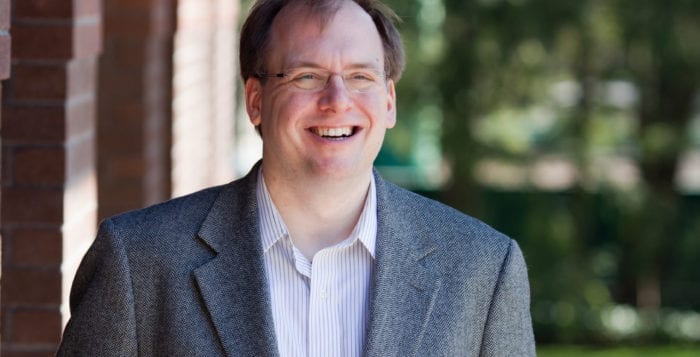CSHL’s Gholson Lyon finds new genetic mutation
By Daniel Dunaief
With the cost of determining the order of base pairs in the human genome decreasing, scientists are increasingly looking for ways to understand how mutations lead to specific characteristics. Gholson Lyon, an assistant professor at Cold Spring Harbor Laboratory, recently made such a discovery in a gene called NAA15.
People with mutations in this gene had intellectual disability, developmental delay, autism spectrum disorder, abnormal facial features and, in some cases, congenital cardiac anomalies.
In a recent interview, Lyon explained that he is trying to understand how certain mutations influence the expression of specific traits of interest, such as intelligence, motor development and heart development. He’s reached out to researchers scattered around the world to find evidence of people who had similar symptoms, to see if they shared specific genetic mutations in NAA15 and found 37 people from 32 families with this condition.
“I really scoured the planet and asked a lot of people about this,” said Lyon, who recently published his research in The American Journal of Human Genetics. The benefit of this kind of work, he explained, is that it can help screen for specific conditions for families at birth, giving them an ability to get an earlier diagnosis and, potentially, earlier treatment. “Being able to identify children at birth and to know that they are at risk of developing these disorders would, in a perfect world” allow doctors to dedicate resources to help people with this condition, he said.
Lyon published a similar study on a condition he named Ogden syndrome seven years ago, in which five boys in a single family died before they reached the age of 3. A mutation in a similar gene, called NAA10, led to these symptoms, which is linked to the X chromosome and was only found in boys.
Lyon found the genes responsible on NAA15 by comparing people with these symptoms to the average genome. The large database, which comes from ExAC and gnomAD, made it possible to do a “statistical calculation,” he said. The next steps in the research is to look for protein changes in the pathway in which these genes are involved. The people he studied in this paper are all heterozygous, which means they have one gene that has a mutation and the other that does not.
With this condition, they have something called haploinsufficiency. In these circumstances, they need both copies of the fully functioning gene to produce the necessary proteins. These mutations likely decrease the function of the protein. Lyon would like to study each of these cases more carefully to understand how much the mutation contributes to the various conditions. He looked for evidence of homozygous mutations but didn’t find any. “We don’t know if they don’t exist” because the defective gene may cause spontaneous miscarriages or if they just didn’t find them yet, he said.
Lyon plans on reaching out to geneticist Fowzan Alkuraya, who was trained in the United States and is working at King Faisal Specialist Hospital and Research Centre clinic in Saudi Arabia. The geneticist has studied the genes responsible for a higher rate of genetic disorders linked to the more common practice of people having children with cousins in what are called consanguineous marriages.
Alkuraya works on the Saudi Human Genome Program, which studies the inherited diseases that have a higher incidence in Saudi Arabia.
For Lyon, finding the people who carry this mutation was challenging, in part because it hasn’t run in the family for multiple generations. Instead, Lyon and his colleagues, including Holly Stessman of Creighton University in Omaha, Nebraska and Linyan Meng at Baylor College of Medicine in Houston, Texas, found 32 unrelated families. In some of these families, one or two siblings carried this mutation in a single mutation.
By defining a new genetic disease, the scientists could help families seeking a diagnosis, encourage the start of early intervention such as speech therapy and connect patients with the same diagnosis. This can provide a support network in which people with this condition and their families know they are not battling this genetic challenge alone, Meng, the assistant laboratory director at Baylor Genetics and assistant professor at Baylor College of Medicine, explained in an email.
Every patient with an NAA15 mutation won’t have the same symptoms. “We see a range of phenotypes in these patients, even though they carry the same diagnosis with defects in the same disease,” Meng added. “Early intervention could potentially make a difference for NAA15 patients.”
Lyon works as a psychiatrist in Queens providing medication management. During his undergraduate years at Dartmouth College, in Hanover, New Hampshire, Lyon said he was interested in neurology and psychology. As he went through his residency at NYU, Columbia and New York State Psychiatric Institute, he gravitated toward understanding the genetic basis of autism, which he said is easier than conditions like schizophrenia because autism is more apparent in the first few years of life.
Lyon recently started working part time at the Institute for Basic Research in Developmental Disabilities on Staten Island. While Lyon appreciates the opportunity to work there, he is concerned about a potential loss of funding. “These services are vital” on a clinical and research level, he said. He is concerned that Gov. Andrew Cuomo (D) is thinking about decreasing the budget for this work. Reducing financial support for this institution could cause New York to lose its premiere status in working with people with developmental disabilities, he said.
“It has this amazing history, with an enormous number of interesting discoveries in Down syndrome, Alzheimer’s disease and Fragile X,” he said. “I don’t think it gets enough credit.”
As for his work with NAA, Lyon plans to continue to search for other people whose symptoms are linked to these genes. “I am looking for additional patients with mutations in NAA10 or NAA15,” he said.







